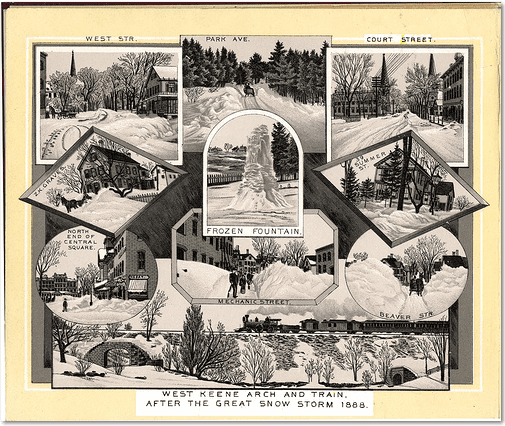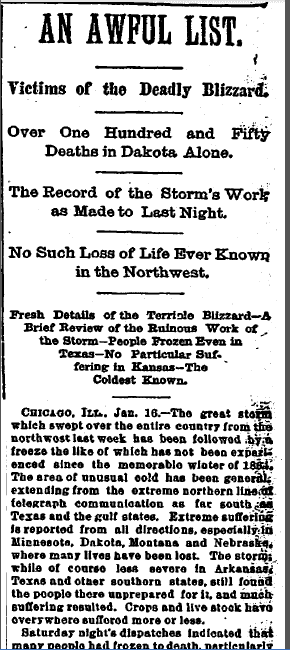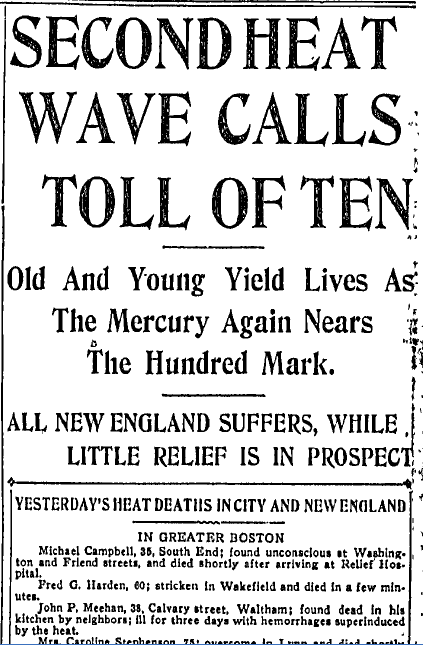Introduction: In this article, Gena Philibert-Ortega researches old newspaper articles to show how severe weather deeply affected our ancestors’ lives. Gena is a genealogist and author of the book “From the Family Kitchen.”
Last week I went to pick up my son from a pool party and the outside temperature was 100 degrees at 9:00 p.m. While I expect it to be hot in the summer during the daytime, when it’s 100 degrees at night I know we’re in store for a heat wave.
There can be no doubt that the weather significantly affected our ancestors’ lives, even that of more recent generations. In my own family, my grandparents moved from the Los Angeles area to Indio, California, a desert community near Palm Springs, in the 1950s. The average daily high in the summer months is well over 100 degrees. Because my grandfather worked for the railroad, when he wasn’t sitting in a train in the heat he was working outside. Having traveled to that area many times I can’t imagine living there without air conditioning.
How did the weather affect your ancestors? Did they or a family member suffer an injury or die due to extreme cold or heat? Do you ever consider how the weather affected your ancestors’ everyday lives?

The Children’s Blizzard of 1888
Stories of the deadly consequences of severe weather filled our ancestors’ hometown newspapers. For those with Great Plains ancestors, the 12 January 1888 blizzard known as “The Children’s Blizzard” has great historical significance. This tremendously strong storm, which spread all the way to New England, caught everyone by surprise—including children at school, some of whom died because they couldn’t get home and the schools lacked provisions. This blizzard is chronicled in the book The Children’s Blizzard by David Laskin. Those who have read the “Little House on the Prairie” series by Laura Ingalls Wilder are familiar with this extreme blizzard because it’s depicted in the book The Long Winter.
This 1888 Missouri newspaper article reported the “awful list” of victims from the severe blizzard.

Newspapers are filled with articles reporting severe blizzards in history.
Extreme Heat Wave Hit New England
Sudden weather anomalies like blizzards weren’t the only type of weather that had dire consequences for our ancestors. Extreme heat—especially the inability to escape it—was also something that took its toll on our ancestors. This article from a 1911 Massachusetts newspaper reports on those who died from a heat wave blasting New England, including a man who was run over by his horse-drawn cart when the horses went crazy from the heat.

Newspapers provide information on the day-to-day weather in your ancestors’ communities. Explore them to find stories of extreme storms and severe weather throughout history. Newspapers also printed old daily almanac weather reports and bulletins that can give you insight into the weather conditions that affected your ancestors’ lives.
Once you’ve researched these articles to identify extreme weather stories and weather records, consider searching a manuscript collection for a diary or journal in which someone describes how the weather on a particular day affected the city or town.
Another good source of historical weather information is Google Books. Titles such as The Weather and Climate of Chicago by Henry Joseph Cox and John Howard Armington, and Maryland Weather Service by Maryland Weather Service, Forrest Shreve and Oliver Lanard Fassig, provide weather data back to the beginning of the 19th century.
The weather affected all aspects of our ancestors’ lives from their work to their everyday living circumstances. Take a look at their area’s newspapers for the story behind the weather—one more way historical newspapers help you flesh out the names and dates on your family tree to get to know your ancestors better, the lives they led, and the times they lived in.

How can I find out about extreme weather conditions in Columbus Mississippi in the early 1900’s . I think it was a flood that killed my great uncle and even if there is some type of list of the casualties?
Terri,
Could this possibly be The Tombigbee Flood of 1892? To learn more about this or any flood you will want to look for local history books that will tell the story of the flood and its aftermath. You may also want to check out The Monthly Weather Review available on Google Books.
Newspapers will be your best bet for not only the reporting of the flood but the lists of those injured or killed . Make sure that you search through the newspaper for the days and even weeks after the flood.
One last thing to consider is to contact a museum or archive in that area and inquire about any documents they have about the flood. Local researchers may have put together information on that event that may include casualties.
Good luck in your search. Thanks for your question.
Gena
I’m surprised you didn’t mention the year with no summer, 1816. A volcano in the south seas spewed so much ash in 1815 that there was no summer in America or Europe. People even ate grass as crops froze etc. My ancestors in NY were farmers and must have had a hard time though farmers at least had a little to eat but nothing to sell. Europe and China were also affected.
Thanks Nancy for sharing that. There’s so many different extreme weather stories it was hard to spotlight just a few for this post.
What I like about that 1816 weather event is that it involved a volcano in a different part of the world. We don’t often consider how international events could have impacted our ancestors in the United States.
Gena
What a great idea. More research to do! Recently another blogger and I found our ancestors both worked in the produce business on the same street in Houston, TX and pictures of flooding that surely affected both of them. Another layer of ancestor stories.
Images and newspaper stories certainly add an important layer to an ancestor’s story. I think they help tell the story that even the non-genealogists in our families will enjoy.
Thanks Kathy, for sharing your experience and taking time to comment.
Gena